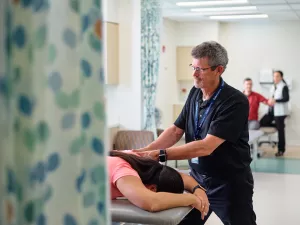Physical therapy can help you regain essential abilities like balance, coordination and muscle strength after an illness, injury or surgery.
Helping you feel like yourself, one step at a time
When you're on the road to recovery, pain and limited mobility can make it difficult to see the light at the end of the tunnel. But with physical therapy, we can help you rediscover a comfortable, more independent quality of life.
We offer a full spectrum of adult, adolescent and pediatric physical therapy, occupational therapy, and other rehabilitation services. Our team includes some of the brightest minds in medicine, with years of experience rehabilitating people living with neurological diseases, back pain, sports injuries, arthritis, stroke and more.

Conditions
If you’re living with any of these conditions, physical therapy can help get your life back on track:
Treatments
Your physical therapist will work together with you to create a treatment path tailored to your needs. Some of the more common treatment strategies include:
- Education about your condition and treatment
- Electrotherapy
- Functional training
- Hand therapy
- Heat and cold modalities
- Manual therapy
- Occupational therapy
- Therapeutic exercise
Care while in the hospital
Some roads to recovery require around-the-clock care in a hospital environment, especially if you or a loved one have experienced a(n):
- Heart failure
- Heart surgery or transplant
- Hip and knee replacement
- Injury resulting from a car accident or other traumatic event
- Stroke
- Surgery
Our physical therapists will work with you and the rest of your care team so that you can head home or to the next destination in your rehab journey.
Outpatient care
Physical therapy that doesn’t require an overnight stay in the hospital is called outpatient care. This type of physical therapy is common for things like ongoing treatment for conditions affecting function and mobility, like:
- Arthritis
- Back and neck pain
- Sports injuries
- Weakened pelvic floor muscles
- Surgery recovery
- Balance
We can also teach you ways to manage and treat your condition at home.
Athletic training + community support
Athletic training is a medical specialty that supports our community both on and off the field. Our athletic trainers offer concussion management, injury evaluation and complete wellness training so you can perform at your best.
You can count on our athletic trainers to have your back when you're in need of:
- Concussion assessment and management
- Examination and clinical diagnosis
- Injury and illness prevention
- Injury evaluation and emergent care
- Physical therapy for rehabbing injuries and medical conditions
- Strength training programs
- Therapeutic intervention
- Wellness promotion and education
High school is a great time to become part of a team, from football to basketball to swimming, gymnastics, wrestling and soccer. Because these sports work your body in different ways, we want to ensure that you’re practicing and playing safely. We partner with local high schools to:
- Develop emergency action plans for athletic departments
- Oversee concussion programs
- Provide sports medicine care
- Provide athletic training for every practice and game
Targeted therapies
We host one of Boston’s only physical therapy clinics for treatment of lymphedema, which is a condition that causes chronic swelling in the arms, legs or other body parts. We have a certified lymphedema therapist on staff who can offer symptom relief using a treatment known as complete decongestive therapy.
Rehabilitation following elbow or hand surgery is an important stop along your road to recovery. Hand therapy improves your strength and overall function. Our specialists will teach you how to properly perform different exercises and strategies like:
- Functional skills retraining
- Hand splinting
- Scar management
- Sensory retraining
- Strengthening and range of motion exercise programs
Your "pelvic floor” is a group of organs known as your core — small and large intestine, stomach, liver, pancreas and gallbladder. Pelvic floor muscles also keep your organs in place while supporting bodily functions like going to the bathroom and having sex.
You may benefit from pelvic floor physical therapy if you’ve noticed weakened or sore pelvic floor muscles.

From regular office visits to inpatient stays, find the healthcare you need and deserve close to home.

Meet the doctors and care team devoted to supporting you every step of the way along your path to better health.